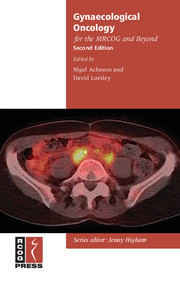Book contents
- Frontmatter
- Contents
- About the authors
- Preface
- Introduction to the second edition
- Abbreviations
- 1 Basic epidemiology
- 2 Basic pathology of gynaecological cancer
- 3 Preinvasive disease of the lower genital tract
- 4 Radiological assessment
- 5 Surgical principles
- 6 Role of laparoscopic surgery
- 7 Radiotherapy: principles and applications
- 8 Chemotherapy: principles and applications
- 9 Ovarian cancer standards of care
- 10 Endometrial cancer standards of care
- 11 Cervical cancer standards of care
- 12 Vulval cancer standards of care
- 13 Uncommon gynaecological cancers
- 14 Palliative care
- 15 Emergencies and treatment-related complications in gynaecological oncology
- Appendix 1 FIGO staging of gynaecological cancers
- Index
3 - Preinvasive disease of the lower genital tract
Published online by Cambridge University Press: 05 August 2014
- Frontmatter
- Contents
- About the authors
- Preface
- Introduction to the second edition
- Abbreviations
- 1 Basic epidemiology
- 2 Basic pathology of gynaecological cancer
- 3 Preinvasive disease of the lower genital tract
- 4 Radiological assessment
- 5 Surgical principles
- 6 Role of laparoscopic surgery
- 7 Radiotherapy: principles and applications
- 8 Chemotherapy: principles and applications
- 9 Ovarian cancer standards of care
- 10 Endometrial cancer standards of care
- 11 Cervical cancer standards of care
- 12 Vulval cancer standards of care
- 13 Uncommon gynaecological cancers
- 14 Palliative care
- 15 Emergencies and treatment-related complications in gynaecological oncology
- Appendix 1 FIGO staging of gynaecological cancers
- Index
Summary
Introduction
This chapter concentrates mainly on premalignancy of the cervix, as this is the most common of the preinvasive conditions and the only one that is screened for on a population basis. Most of the information about cervical premalignancy refers to squamous lesions, as these are by far the most frequent. Preinvasive disease of the glandular endocervical epithelium will also be considered, as will preinvasive conditions of the vagina and vulva.
Preinvasive disease and terminology
The concept of precancer of the cervix dates back to the end of the 19th century, when Sir John Williams described non-invasive tissue resembling malignancy adjacent to an area of microinvasive carcinoma in a hysterectomy specimen. The term carcinoma in situ (CIS) was introduced in the 1930s. Retrospective studies on archived histological material found CIS lesions in women who subsequently went on to develop cervical cancer and so the precursor nature of CIS to cervical cancer came to be established. Subsequent prospective studies have confirmed these findings.
When the Papanicolaou smear was introduced in the 1940s and abnormalities investigated, it became obvious that there were changes not amounting to CIS but still showing similar features. These lesser changes were initially referred to as 'dysplasia'. Apart from being an imprecise term covering a range of abnormalities from normal to CIS, many other terms were also in use. This resulted in confusion in management: women with CIS were usually treated by hysterectomy – sometimes radical hysterectomy – whereas those with dysplasia were often disregarded.
Keywords
- Type
- Chapter
- Information
- Gynaecological Oncology for the MRCOG and Beyond , pp. 35 - 52Publisher: Cambridge University PressPrint publication year: 2011

